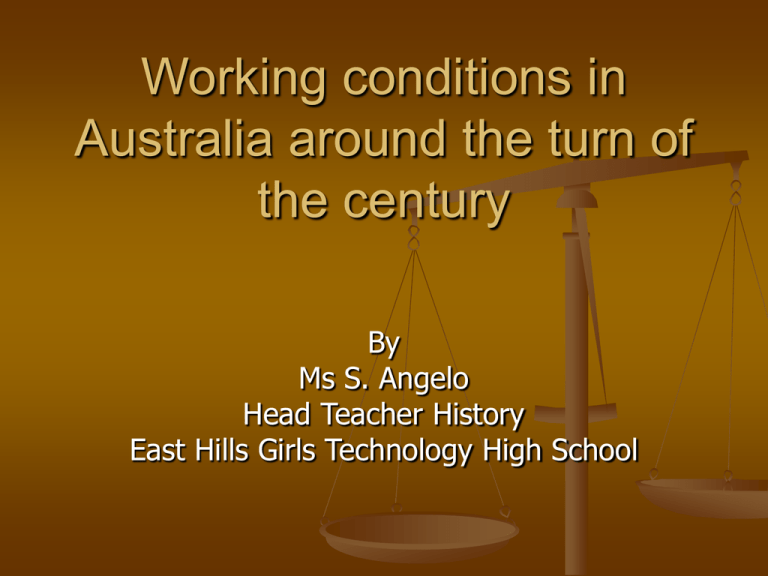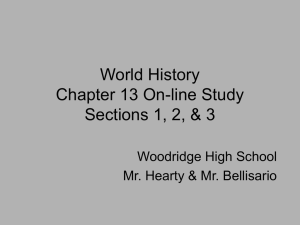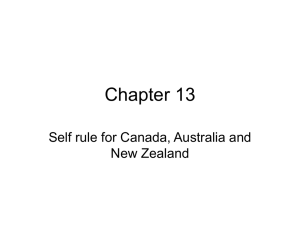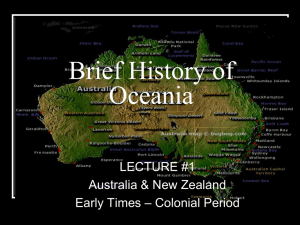Working conditions in Australia around the turn of the century
advertisement

Working conditions in Australia around the turn of the century By Ms S. Angelo Head Teacher History East Hills Girls Technology High School Asking Historical Questions What image is created by the expression “A Working Man’s Paradise”? What kind of conditions do you think would exist in “A Working Man’s Paradise”? Does the expression include all workers? Who would use the expression? Why would they use it? A Working Man’s Paradise Australia was considered to be a ‘working man’s paradise’ in the early 1900s It was a phrase used by colonial politicians and employer groups to attract workers to the colonies that made up Australia in the 1800s It suggested that Australia was a better place to work than Britain An Accurate Image? Primary Industries From Federation to World War I Australia continued it’s economic growth Exporting primary products – wheat and wool Overseas borrowing to finance development After 1903 the wool industry rapidly grew Refrigeration allowed the export of mutton William Farrer developed a rust resistant strain of wheat and led to a doubling of wheat exports 1901 – 1913 Development of railways, irrigation schemes helped expand Primary Industries Mining and Manufacturing Mining continued to expand copper and tin (Qld & TAS) Silver and zinc (NSW- Broken Hill) Iron ore (SA) 1909 Iron and steel works – (NSW – Newcastle) Although Australia was not highly developed in its manufacturing sector Factory workers almost doubled 1901 – 1913 Australia needed tariffs to help protect its manufacturing sector from cheaper imports Working Conditions Middle class people generally worked in “White Collar” jobs – offices, professions, self-employed Poorer people tended to work in “Blue Collar” jobs – factories and in service Conditions of employment were very tough and would not be accepted today Employers tended to ignore laws about working conditions Hours were long and wages were low Women only earned 50% of a man’s wage for the same work Men were considered to be the “Bread Winner” Some Positives Skilled workers were well paid in comparison to other countries Working conditions tended to be better than other countries as well Australia led the world in industrial relations and social welfare Australia had a warmer climate than Britain Workers generally had a better diet in Australia compared to Britain (meat and tea) A higher percentage of workers in Australia owned their own homes compared to Britain 8 hour day achieved in Australia before Britain Some Negatives Conditions in factories in summer were often unbearable in the heat Rural workers had to contend with drought, bushfires and isolation Rents were higher in Australia compared to Britain Majority of unskilled workers in Australia did not get the benefit of the 8 hour day including women, child workers, Aboriginal and Torres Strait Islander, or Chinese workers Women and Work: Using Sources Read Sources 1.14, 1.15, and 1.16 in Investigating Australia’s 20th Century History on page 13 Answer Questions 1 - 3 Work Place Laws After an economic depression the 1890s saw a number of strikes Maritime Strike of 1890 in Vic, NSW, Qld, SA Shearers’ Strikes in 1891 and 1894 in Qld Miners’ Strike in 1892 – Broken Hill NSW Government supported the employers Police were used to control demonstrations Unions were defeated and returned to work Previous gains were lost End of Presentation











